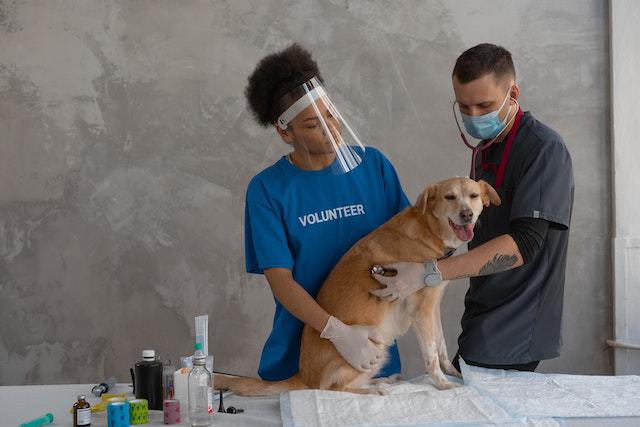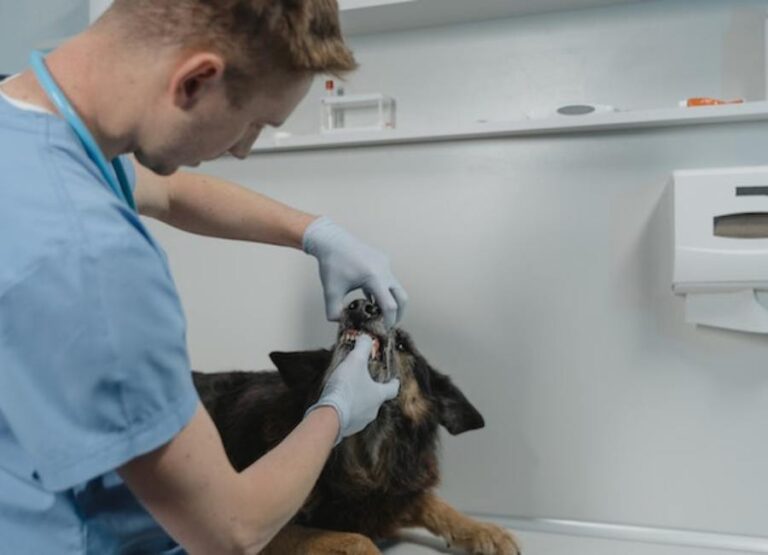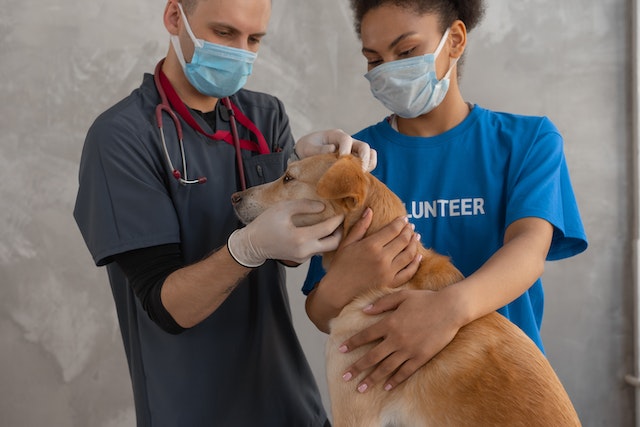18 Most Common Dog Health Problems Explained

Hey there, fellow dog lovers! Are you worried about your furry friend’s health and well-being? Let’s discuss some common dog health problems…
In this blog post, we’ll dive into some common dog health problems, shedding light on prevention, symptoms, and treatment options.
Let’s get started…
Dog Health Problems
Dog health problems can range from minor issues to serious conditions, the most common problems include skin allergies, dental disease, and obesity.
Regular veterinary check-ups, a balanced diet, and regular exercise can help prevent and manage these health problems in dogs.
Let’s dive deeper…
The following are some of the most common dog health problems:
1. Obesity
Obesity in dogs is a prevalent health problem that can have serious consequences. The primary causes of obesity in dogs are overfeeding and lack of exercise.
Signs of obesity in dogs include excessive weight gain, difficulty breathing, lethargy, and joint problems.
To prevent obesity, dog owners should provide a balanced diet, control portion sizes, and engage in regular exercise with their pets.
Treatment for obesity in dogs involves a combination of dietary management and increased physical activity.
Veterinary guidance is essential to develop a tailored weight loss plan for each dog, considering their individual needs and health conditions.
2. Arthritis
Arthritis in dogs is a common health problem characterized by inflammation and degeneration of the joints.
The condition can be caused by various factors, including genetic predisposition, aging, obesity, joint trauma, and certain diseases like hip dysplasia.
Signs of arthritis in dogs may include stiffness, lameness, reluctance to move, difficulty in getting up or lying down, and behavioral changes.
Prevention of arthritis can be achieved through weight management, regular exercise, and providing a balanced diet with joint-supportive supplements.
Treatment options for arthritis in dogs include non-steroidal anti-inflammatory drugs (NSAIDs), physical therapy, weight management, joint supplements, and in severe cases, surgery.
Early diagnosis and proper management are crucial in improving the quality of life for dogs suffering from arthritis.
Read more about identifying a dog in pain.
3. Kennel cough
Kennel cough, also known as canine infectious tracheobronchitis, is a common health problem in dogs. It is highly contagious and can be caused by various viruses and bacteria, including Bordetella bronchiseptica.
The main signs of kennel cough include a persistent dry cough, gagging, and retching. Dogs may also exhibit lethargy, loss of appetite, and nasal discharge.
Prevention of kennel cough involves vaccination, especially if the dog is frequently exposed to other dogs in boarding facilities, grooming salons, or dog parks. Proper hygiene and sanitation in these environments are also crucial.
Treatment for kennel cough typically involves supportive care, such as rest, good nutrition, and ensuring the dog stays hydrated.
In some cases, antibiotics may be prescribed to treat any bacterial infections. It is important to isolate the affected dog to prevent the spread of the disease. Regular follow-up with a veterinarian is essential to monitor the dog’s progress and ensure a full recovery.
4. Ear infections
Ear infections are a common health problem in dogs, with several possible causes. One of the primary causes is the buildup of excess moisture in the ear canal, which creates a favorable environment for bacterial or yeast overgrowth.
Other factors, such as allergies, ear mites, or foreign objects, can also contribute to ear infections.
Signs of an ear infection in dogs include scratching or rubbing the ears, head shaking, redness or swelling of the ear canal, foul odor, and discharge.
To prevent ear infections, it is essential to keep the ears clean and dry, especially after swimming or bathing. Regular ear inspections and grooming can help identify and address any potential issues.
Treatment for ear infections typically involves cleaning the ears with a veterinarian-recommended solution, followed by medication, such as antibiotics or antifungal drugs, if necessary. It is crucial to consult a veterinarian for accurate diagnosis and treatment guidance.
5. Dental Problems
Dental problems in dogs are a common health issue that can cause discomfort and affect their overall well-being.
The primary cause of dental problems in dogs is the buildup of plaque and tartar on their teeth, which can lead to gum disease, tooth decay, and bad breath.
Signs of dental problems in dogs include difficulty chewing, drooling, swollen or bleeding gums, and reluctance to eat.
Prevention of dental problems in dogs includes regular dental care, such as brushing their teeth, providing dental treats or toys, and scheduling professional dental cleanings.
It is essential to maintain a healthy diet and avoid feeding dogs with sugary or sticky foods that can contribute to dental issues.
Treatment for dental problems in dogs may involve professional dental cleaning under anesthesia, extraction of damaged teeth, and the use of antibiotics to treat infections.
Dental X-rays may also be necessary to assess the extent of the problem. Regular veterinary check-ups and proactive dental care are crucial to preventing and managing dental problems in dogs to ensure their oral health and overall well-being.
6. Diabetes
Diabetes in dogs is a common health problem characterized by the inability of the body to regulate blood sugar levels. The causes of diabetes in dogs can vary, but it is often linked to genetic predisposition, obesity, and certain medications.
Signs of diabetes in dogs include increased thirst, frequent urination, weight loss despite a good appetite, and lethargy. If left untreated, diabetes can lead to more serious complications like cataracts and kidney disease.
Prevention of diabetes in dogs involves maintaining a healthy weight through regular exercise and a balanced diet. Regular veterinary check-ups can also help detect any early signs of the disease.
Treatment for diabetes in dogs typically involves insulin therapy, which requires regular injections to help regulate blood sugar levels. A veterinarian will determine the appropriate insulin dosage based on the dog’s individual needs.
Monitoring blood glucose levels at home and making necessary adjustments to the insulin dosage, along with a consistent feeding schedule, are crucial for the successful management of diabetes in dogs. With proper care and management, dogs with diabetes can live happy and healthy lives.
7. Luxating patella
Luxating patella, also known as a dislocated kneecap, is a common health problem in dogs. It occurs when the kneecap moves out of its normal position and can lead to pain and difficulty walking. The condition can be caused by various factors, including genetics, trauma, or structural abnormalities in the dog’s legs.
Signs of a luxating patella may include limping, skipping steps, or favoring one leg. In some cases, the dog may experience intermittent lameness or a complete inability to bear weight on the affected leg.
Prevention of luxating patella can be challenging, as it is often a genetic condition. However, maintaining a healthy weight and avoiding excessive jumping or strenuous exercise can help reduce the risk. Regular veterinary check-ups can also aid in early detection and management.
Treatment options for luxating patella depend on the severity of the condition. Mild cases may be managed through weight management, physical therapy, and pain medication. In more severe cases, surgical intervention may be necessary to realign the kneecap and stabilize the joint.
Overall, early diagnosis and appropriate management are crucial in ensuring the well-being and mobility of dogs affected by luxating patella. Consulting with a veterinarian is essential for an accurate diagnosis and tailored treatment plan.
8. Hip dysplasia
Hip dysplasia is a common health problem in dogs, particularly in larger breeds. It is a condition where the hip joint doesn’t develop properly, leading to instability and potential pain.
The exact cause of hip dysplasia is not fully understood, but it is believed to be a combination of genetic and environmental factors.
Some signs of hip dysplasia in dogs include difficulty in walking or running, lameness, reluctance to exercise, and a bunny-hop-like gait.
Prevention of hip dysplasia involves careful breeding practices, including screening potential breeding dogs for the condition.
Treatment options for hip dysplasia range from conservative management, such as weight control and physical therapy, to surgical interventions like total hip replacement.
Early diagnosis and management are crucial for minimizing pain and improving the quality of life for dogs with hip dysplasia.
9. Heart Disease
Heart disease in dogs is a common health problem that can affect dogs of all breeds and sizes. There are several possible causes of heart disease in dogs, including genetic factors, age, obesity, and underlying medical conditions such as high blood pressure or heartworm disease.
Signs of heart disease in dogs may include coughing, difficulty breathing, decreased energy levels, and fluid retention in the abdomen or limbs. It is important to note that these signs can vary depending on the specific type and stage of heart disease.
Prevention of heart disease in dogs involves maintaining a healthy lifestyle for your pet, including regular exercise, a balanced diet, and routine veterinary check-ups. Additionally, early detection of any underlying medical conditions that may contribute to heart disease is crucial.
Treatment for heart disease in dogs typically involves a combination of medication, dietary changes, and lifestyle modifications. Medications may include diuretics to manage fluid retention, ACE inhibitors to improve heart function, and beta-blockers to control heart rate.
In some cases, surgical interventions such as pacemaker implantation or heart valve repair may be necessary.
Overall, early detection, proper management, and regular veterinary care are key to preventing and treating heart disease in dogs, ensuring a better quality of life for our furry companions.
10. Cancer
Cancer in dogs is a prevalent health problem that can affect dogs of all ages and breeds. There are several possible causes of cancer in dogs, including genetic predisposition, exposure to environmental toxins, and certain viral infections.
The signs of cancer in dogs can vary depending on the type and location of the tumor, but common symptoms include abnormal lumps or bumps, weight loss, decreased appetite, and lethargy.
Prevention of cancer in dogs is challenging, but maintaining a healthy lifestyle with regular exercise, a balanced diet, and routine veterinary check-ups can help reduce the risk.
Treatment options for cancer in dogs may include surgery, chemotherapy, radiation therapy, and immunotherapy, depending on the stage and type of cancer.
Early detection and prompt treatment are crucial for improving the prognosis and quality of life for dogs with cancer.
11. Diarrhea and Vomiting
Diarrhea and vomiting are common health problems in dogs. They can be caused by various factors such as dietary indiscretion, food allergies, viral or bacterial infections, parasites, or underlying health conditions.
The signs of diarrhea and vomiting in dogs include loose stool, frequent bowel movements, dehydration, lethargy, and loss of appetite.
To prevent these issues, it is important to provide a balanced diet, avoid sudden changes in food, and keep the dog away from garbage or toxic substances.
Regular deworming and vaccinations can also help prevent infections. If diarrhea and vomiting occur, it’s crucial to seek veterinary care for a proper diagnosis.
Treatment for diarrhea and vomiting in dogs may involve dietary modifications, medication to control symptoms, fluid therapy to prevent dehydration, and addressing the underlying cause. It is important to follow the veterinarian’s instructions and monitor the dog’s progress during the treatment process.
Read more about food you shouldn’t give your dog.
12. Eye Problems
Eye problems in dogs are a common health issue that can have various causes. Some potential causes include infections, allergies, trauma, genetic predisposition, or underlying medical conditions.
Signs of eye problems in dogs may include redness, discharge, excessive tearing, squinting, cloudiness, or changes in the appearance of the eye.
Preventive measures include regular veterinary check-ups, keeping the eyes clean and free from irritants, and protecting the dog’s eyes from potential injury.
Treatment for eye problems in dogs depends on the specific condition and may involve medications, eye drops, ointments, or even surgery if necessary. It is crucial to seek veterinary attention promptly to prevent complications and ensure the well-being of the dog’s eyes.
13. Fleas and Ticks
Fleas and ticks are common dog health problems caused by external parasites. They can infest dogs through contact with other infested animals or environments.
Signs of flea or tick infestation in dogs include excessive itching, redness, hair loss, and the presence of small insects or dark specks on the fur.
Prevention involves regular grooming, using flea and tick prevention products, and keeping the dog’s environment clean.
Treatment options include topical or oral medications specifically designed to kill fleas and ticks, as well as regular bathing and grooming to remove the parasites.
It is important to consult with a veterinarian to determine the most appropriate prevention and treatment methods for your dog.
Overall, addressing flea and tick infestations promptly is crucial to ensure the health and comfort of your furry friend.
14. Allergies
Allergies in dogs are a common health problem that can cause discomfort and distress. They can be caused by various factors, including environmental triggers like pollen, dust mites, or mold, as well as food allergies or flea bites.
The signs of allergies in dogs may vary, but commonly include itching, redness, rashes, sneezing, and gastrointestinal issues.
Prevention of allergies in dogs involves identifying and avoiding the allergens that trigger a reaction. This can be done through regular cleaning, using hypoallergenic products, and providing a balanced diet free from allergenic ingredients. In some cases, medication or immunotherapy may be necessary to manage the symptoms.
Treatment for allergies in dogs often involves a multi-faceted approach, which may include antihistamines, corticosteroids, or immunosuppressive drugs to control inflammation and itching.
Additionally, topical creams or shampoos can provide relief for skin irritations. It is crucial to consult a veterinarian for an accurate diagnosis and proper treatment plan tailored to the individual dog’s needs.
15. Seizures
Seizures in dogs are a common health problem characterized by sudden, uncontrolled electrical activity in the brain. They can be caused by various factors, including genetics, brain tumors, infections, poisoning, or metabolic disorders.
Signs of seizures in dogs may include convulsions, shaking, muscle spasms, drooling, loss of consciousness, or abnormal behavior.
Prevention of seizures involves managing underlying conditions, such as providing a balanced diet, regular exercise, and minimizing exposure to potential triggers.
Treatment options for seizures in dogs typically involve medications, such as anticonvulsants, to regulate brain activity and reduce the frequency and severity of seizures.
It’s important to consult with a veterinarian for a proper diagnosis and to develop a tailored treatment plan for the individual dog.
Regular monitoring and follow-up visits are essential to ensure the dog’s well-being and adjust the treatment if necessary.
16. Urinary Tract Infections
Urinary Tract Infections (UTIs) are a common health problem in dogs. They can be caused by bacteria entering the urinary system through the urethra.
Signs of UTIs in dogs include frequent urination, difficulty urinating, blood in the urine, and increased thirst.
Preventive measures include providing ample hydration, regular bathroom breaks, and maintaining good hygiene. Treatment usually involves antibiotics prescribed by a veterinarian after a proper diagnosis.
17. Liver disease
Liver diseases are a common health problem in dogs, with various possible causes. These may include infections, toxins, medications, genetics, and underlying health conditions.
Signs of liver disease in dogs can include jaundice, vomiting, diarrhea, weight loss, increased thirst, and changes in behavior.
Prevention involves maintaining a healthy diet, avoiding exposure to toxins, and regular veterinary check-ups. Treatment may include medications, dietary changes, and supportive care to manage symptoms and improve liver function.
18. Pancreatitis
Pancreatitis is a common health problem in dogs that involves inflammation of the pancreas. The possible causes of pancreatitis in dogs can include a high-fat diet, obesity, certain medications, and underlying medical conditions.
Signs of pancreatitis in dogs may include abdominal pain, vomiting, diarrhea, and decreased appetite. Prevention of pancreatitis in dogs involves maintaining a balanced diet, avoiding high-fat foods, and regular exercise.
Treatment for pancreatitis in dogs typically includes supportive care, such as intravenous fluids and pain medication, along with dietary changes and potentially antibiotics.
Read more about identifying a sick dog.
Conclusion
In conclusion, taking care of our furry companions’ health is essential for their overall well-being.
Remember to stay proactive by scheduling regular check-ups with your veterinarian, keeping up with vaccinations, and maintaining a balanced diet.
By being attentive to their needs, we can ensure that our dogs live long, happy, and healthy lives.


![Anxiety In Dogs [Causes, Signs, & Remedies] Anxiety In Dogs](https://petcreeks.com/wp-content/uploads/2023/12/simon-hurry-_LhjpmruUAo-unsplash.jpg)


![Cancer In Beagles Symptoms [10 Potential Symptoms] Cancer In Beagles Symptoms](https://petcreeks.com/wp-content/uploads/2023/05/Cancer-In-Beagles-Symptoms-768x555.jpg)
